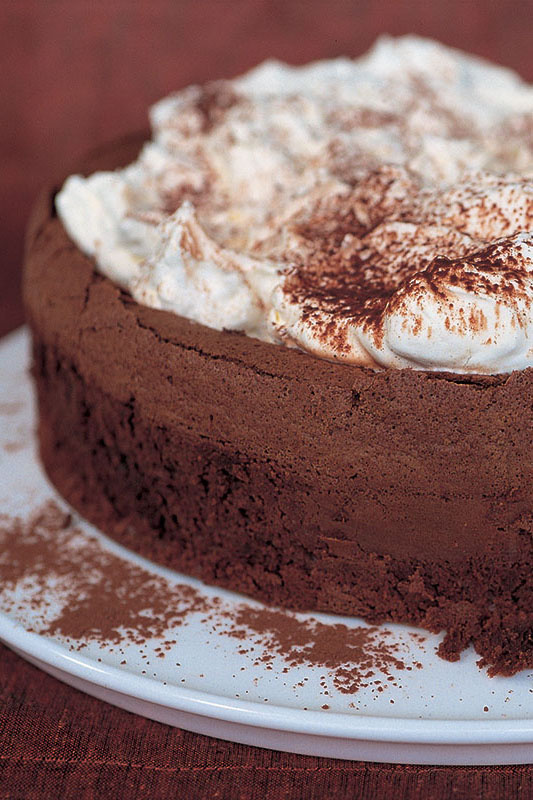Chocolate Manjari Cake
by Nadine Ingram, featured in Flour and Stone Published by Simon & Schuster AustraliaIntroduction
This is my signature chocolate cake that I have baked for just about everyone I love over the years. It has been a cake for life, a cake for joy and even a cake for sorrow, proving that the healing power of cake should never be underestimated. I've recently started using Manjari Valrhona chocolate from Madagascar for this recipe. Since Manjari has over 60% cocoa solids, I supplement the recipe with a Valrhona chocolate called Jivara, otherwise the chocolate quality is too rich. That said, I have also used bars of Dairy Milk with equally soulful results. So it is not essential to use a chocolate high in cocoa solids.

Share or save this
Ingredients
Serves: 10
- 200 millilitres double cream
- 200 grams Valrhona Manjari chocolate
- 50 grams Valrhona Jivara chocolate
- 3 large eggs
- 125 grams caster sugar
- 125 millilitres milk
- 1 lemon (cut in half)
- 50 grams good-quality cocoa powder - plus extra for dusting (optional)
- 5 (150g) large egg whites
- a pinch of salt
To serve:
- clotted cream or ice-cream
Method
Chocolate Manjari Cake is a guest recipe by Nadine Ingram so we are not able to answer questions regarding this recipe
- Preheat the oven to 140°C and line a 22 cm round cake tin with baking paper.
- Whip the cream to soft peaks, then place in a bowl and store in the fridge until needed. This will free up your mixing bowl for the other whipping you have to do.
- Place both types of chocolate in a stainless steel bowl over a saucepan of barely simmering water until they are half melted. Make sure the bottom of the bowl doesn't touch the water or the chocolate will seize. Remove the bowl from the heat and place to one side - there should still be unmelted pieces of chocolate in the bowl.
- Meanwhile, place the eggs and 90 g of the caster sugar in the bowl of an electric mixer fitted with the whisk attachment. Beat on high speed for about 5 minutes until it is thick and fluffy (this is called a sabayon).
- Pour the milk into another little saucepan, then squeeze the lemon juice directly into the milk, stirring with a wooden spoon to combine. Bring to the boil and don't worry if it curdles - it is meant to (the purpose is to make the cake more bitter rather than a sweet chocolate cake). Take the milk off the heat and allow it to cool for 1 minute, then pour the milk directly over the melted chocolate and stir gently to combine. Don't whisk or stir too vigorously at this stage - just roughly mix it together. Gently fold in the cocoa powder.
- Fold one-third of the sabayon into the melted chocolate with a spatula, then another third and finally the remaining sabayon. Don't be too concerned about making sure the batter is streak free before adding the next batch. You have a lot of folding to do yet and we want to preserve as much of the lovely air you have beaten into the sabayon as possible.
- Whisk the egg whites on medium speed with a pinch of salt (this will help with the structure of the whipped egg white). Continue whipping until the egg white forms soft ribbons, then gradually add the remaining 35 g caster sugar, being careful at this stage not to over-whip the egg whites. They need to be a little looser than stiff peaks.
- Remove the whipped cream from the fridge and fold it into the chocolate in two batches, then add the egg whites (also in two batches).
- Pour the cake batter into the prepared tin and bake for 1 hour or until the centre springs back when pressed with your finger. For best results, turn the oven off now and leave the cake to cool completely in the oven with the door slightly ajar. This will reduce the amount the cake falls as it cools. Dust the cooled cake with cocoa or leave it plain if you wish.
- To serve: When slicing, first run the knife under hot water and wipe it dry to discourage sticking. Serve with clotted cream or ice-cream.






Tell us what you think
Thank you {% member.data['first-name'] %}.
Explore more recipesYour comment has been submitted.